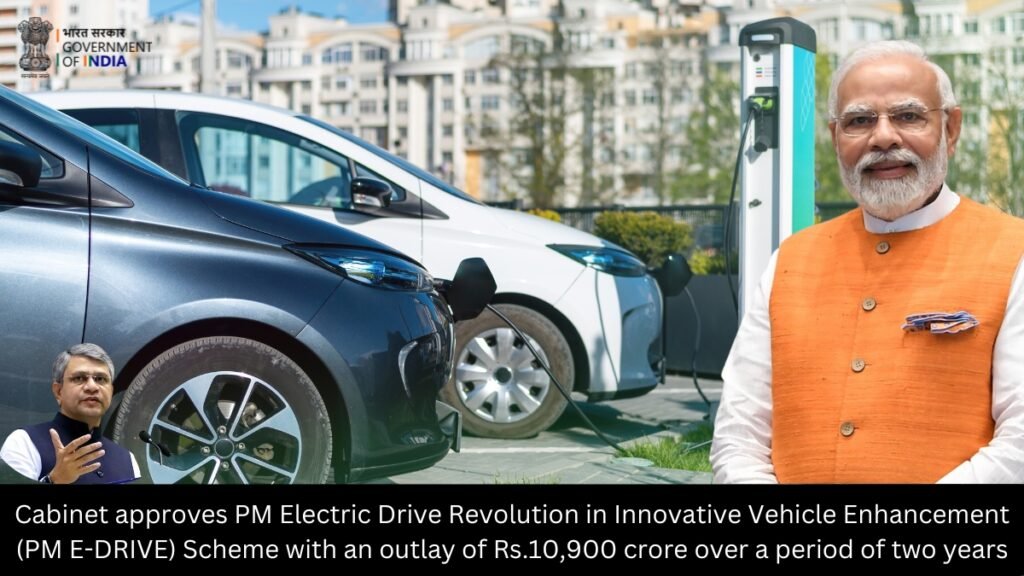PM Electric Drive Revolution in Innovative Vehicle Enhancement (PM E-DRIVE) Scheme:
In a significant move to accelerate the adoption of electric vehicles (EVs) in the country, the Indian government has launched the ‘PM E-Drive’ scheme with a massive ₹10,900 crore outlay. This new initiative, announced by the Cabinet, aims to provide upfront incentives and develop the necessary charging infrastructure to make EVs more accessible and appealing to consumers.
The PM E-Drive scheme will be operational for the next two years and is set to replace the previous FAME (Faster Adoption and Manufacturing of Electric Vehicles) scheme. The new program focuses on supporting the electrification of public transportation, including electric buses, trucks, and ambulances, in addition to promoting the adoption of electric two-wheelers and three-wheelers.
Here are some key points of (PM E-Drive) Scheme to look after :
- Approval and Objective:
- The Union Cabinet, led by Prime Minister Narendra Modi, approved the PM E-DRIVE Scheme with an outlay of Rs 10,900 crore over two years to promote electric mobility in India.
- Demand Incentives:
- Subsidies worth Rs 3,679 crore for e-2Ws, e-3Ws, e-ambulances, e-trucks, and other EVs.
- The scheme aims to support 24.79 lakh e-2Ws, 3.16 lakh e-3Ws, and 14,028 e-buses.
- E-Voucher System:
- Introduction of an Aadhaar authenticated e-voucher system for EV buyers to avail demand incentives.
- E-vouchers are generated at purchase, signed by the buyer, and used by the dealer to claim incentives.
- E-Ambulances:
- Rs 500 crore allocated for deploying e-ambulances to promote comfortable patient transport.
- Performance and safety standards will be developed in consultation with health and transport authorities.
- E-Buses Procurement:
- Rs 4,391 crore allocated for the procurement of 14,028 e-buses by STUs and public transport agencies.
- Demand aggregation managed by CESL in major cities with populations over 40 lakh, including Delhi, Mumbai, Kolkata, and others.
- E-Trucks Deployment:
- Rs 500 crore allocated for incentivizing e-trucks to reduce air pollution.
- Incentives tied to scrapping certificates from approved vehicle scrapping centres.
- Charging Infrastructure:
- Rs 2,000 crore allocated for establishing public charging stations to reduce range anxiety among EV users.
- Planned installations include 22,100 fast chargers for e-4Ws, 1,800 fast chargers for e-buses, and 48,400 fast chargers for e-2Ws/3Ws.
- Modernization of Test Agencies:
- Rs 780 crore allocated for upgrading testing agencies under MHI to support new and emerging EV technologies.
- Focus Areas:
- Supports mass mobility through public transport enhancement.
- Aims to expedite EV adoption and improve air quality by providing incentives and building essential charging infrastructure.
- Aatmanirbhar Bharat and Manufacturing:
- Encourages a competitive and resilient EV manufacturing industry under the Aatmanirbhar Bharat initiative through a phased manufacturing program (PMP).
- Promotes domestic manufacturing and strengthens the EV supply chain.
- Environmental and Economic Impact:
- Addresses environmental pollution, fuel security, and promotes sustainable transport solutions.
- Expected to spur investments in the EV sector, generate employment along the value chain, and foster the establishment of charging infrastructure.
This initiative represents a significant step by the Government of India toward sustainable and eco-friendly transportation, aligning with broader environmental goals and enhancing the nation’s EV ecosystem.
Advantages of the PM E-Drive Scheme
The PM E-Drive scheme offers several key advantages that are expected to drive the adoption of electric vehicles in India. Here’s a table outlining the main benefits:
The advantages of the PM E-Drive scheme include:
- Upfront Incentives: Subsidies and discounts on EV purchases, making them more affordable for consumers.
- Charging Infrastructure: Significant investment in developing public charging facilities across the country.
- Focus on Public Transport: Prioritizing the electrification of buses, trucks, and ambulances to create a visible and accessible EV ecosystem.
- Scalability: Two-year duration allows for a more sustained and focused approach to EV promotion.
- Environmental Benefits: Reduced greenhouse gas emissions and improved air quality.
- Technological Advancement: Potential for innovation and growth in the domestic EV industry.
The scheme’s impact on the common man:
- Affordability: Demand incentives make electric vehicles more accessible and cost-effective.
- Accessibility: Increased availability of electric two-wheelers, three-wheelers, and buses for daily commuting.
- Convenience: Improved charging infrastructure alleviates range anxiety and makes EVs a practical choice.
- User-friendly Approach: The e-voucher system simplifies the process of availing incentives.
In summary, the PM E-Drive scheme represents a significant step forward in India’s transition to sustainable mobility. By addressing the key barriers to EV adoption and providing comprehensive support, the government aims to position the country as a global leader in the electric vehicle revolution, benefiting both the environment and the common man.
As the implementation of the PM E-Drive scheme unfolds, industry experts and policymakers will closely monitor its impact on the EV market, ensuring that the incentives and infrastructure development effectively drive the widespread adoption of electric vehicles across India. The scheme’s success will not only benefit the environment but also contribute to the growth of the domestic automotive industry and create new employment opportunities in the emerging EV ecosystem.”
The PM E-Drive scheme is a clear indication of the government’s unwavering commitment to promoting electric mobility in India. By addressing the key barriers to EV adoption, this initiative has the potential to transform the transportation landscape and pave the way for a sustainable future,” said Anand Mahindra, Chairman of a leading Indian conglomerate.
With the launch of the PM E-Drive scheme, India has taken a significant step towards realizing its ambitious goals of achieving 30% electric vehicle penetration by 2030. The scheme’s comprehensive approach, combining financial incentives and infrastructure development, is expected to catalyze the transition to electric mobility, positioning India as a global pioneer in the sustainable transportation revolution.
Read more – MG Windsor EV


